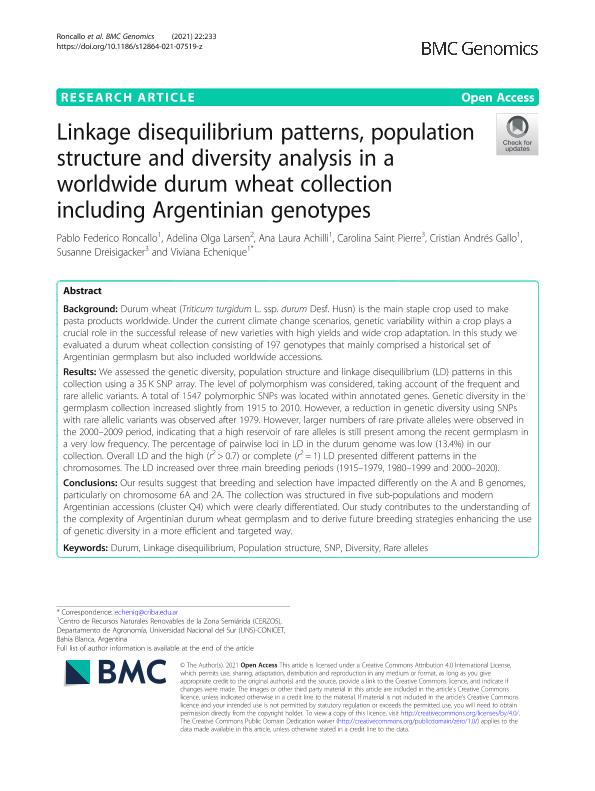Mostrar el registro sencillo del ítem
dc.contributor.author
Roncallo, Pablo Federico

dc.contributor.author
Larsen, Adelina Olga

dc.contributor.author
Achilli, Ana Laura

dc.contributor.author
Saint Pierre, Carolina

dc.contributor.author
Gallo, Cristian Andrés

dc.contributor.author
Dreisigacker, Susanne
dc.contributor.author
Echenique, Carmen Viviana

dc.date.available
2021-06-24T15:10:43Z
dc.date.issued
2021-04-05
dc.identifier.citation
Roncallo, Pablo Federico; Larsen, Adelina Olga; Achilli, Ana Laura; Saint Pierre, Carolina; Gallo, Cristian Andrés; et al.; Linkage disequilibrium patterns, population structure and diversity analysis in a worldwide durum wheat collection including Argentinian genotypes; BioMed Central; BMC Genomics; 22; 5-4-2021; 1-17
dc.identifier.issn
1471-2164
dc.identifier.uri
http://hdl.handle.net/11336/134858
dc.description.abstract
Background: Durum wheat (Triticum turgidum L. ssp. durum Desf. Husn) is the main staple crop used to make pasta products worldwide. Under the current climate change scenarios, genetic variability within a crop plays a crucial role in the successful release of new varieties with high yields and wide crop adaptation. In this study we evaluated a durum wheat collection consisting of 197 genotypes that mainly comprised a historical set of Argentinian germplasm but also included worldwide accessions. Results: We assessed the genetic diversity, population structure and linkage disequilibrium (LD) patterns in this collection using a 35 K SNP array. The level of polymorphism was considered, taking account of the frequent and rare allelic variants. A total of 1547 polymorphic SNPs was located within annotated genes. Genetic diversity in the germplasm collection increased slightly from 1915 to 2010. However, a reduction in genetic diversity using SNPs with rare allelic variants was observed after 1979. However, larger numbers of rare private alleles were observed in the 2000–2009 period, indicating that a high reservoir of rare alleles is still present among the recent germplasm in a very low frequency. The percentage of pairwise loci in LD in the durum genome was low (13.4%) in our collection. Overall LD and the high (r2 > 0.7) or complete (r2 = 1) LD presented different patterns in the chromosomes. The LD increased over three main breeding periods (1915–1979, 1980–1999 and 2000–2020). Conclusions: Our results suggest that breeding and selection have impacted differently on the A and B genomes, particularly on chromosome 6A and 2A. The collection was structured in five sub-populations and modern Argentinian accessions (cluster Q4) which were clearly differentiated. Our study contributes to the understanding of the complexity of Argentinian durum wheat germplasm and to derive future breeding strategies enhancing the use of genetic diversity in a more efficient and targeted way.
dc.format
application/pdf
dc.language.iso
eng
dc.publisher
BioMed Central

dc.rights
info:eu-repo/semantics/openAccess
dc.rights.uri
https://creativecommons.org/licenses/by/2.5/ar/
dc.subject
DIVERSITY
dc.subject
DURUM
dc.subject
LINKAGE DISEQUILIBRIUM
dc.subject
POPULATION STRUCTURE
dc.subject
RARE ALLELES
dc.subject
SNP
dc.subject.classification
Otras Biotecnología Agropecuaria

dc.subject.classification
Biotecnología Agropecuaria

dc.subject.classification
CIENCIAS AGRÍCOLAS

dc.title
Linkage disequilibrium patterns, population structure and diversity analysis in a worldwide durum wheat collection including Argentinian genotypes
dc.type
info:eu-repo/semantics/article
dc.type
info:ar-repo/semantics/artículo
dc.type
info:eu-repo/semantics/publishedVersion
dc.date.updated
2021-06-10T19:25:42Z
dc.journal.volume
22
dc.journal.pagination
1-17
dc.journal.pais
Reino Unido

dc.journal.ciudad
Londres
dc.description.fil
Fil: Roncallo, Pablo Federico. Consejo Nacional de Investigaciones Científicas y Técnicas. Centro Científico Tecnológico Conicet - Bahía Blanca. Centro de Recursos Naturales Renovables de la Zona Semiárida. Universidad Nacional del Sur. Centro de Recursos Naturales Renovables de la Zona Semiárida; Argentina. Universidad Nacional del Sur. Departamento de Agronomía; Argentina
dc.description.fil
Fil: Larsen, Adelina Olga. Instituto Nacional de Tecnología Agropecuaria. Centro Regional Buenos Aires Sur. Estación Experimental Agropecuaria Barrow; Argentina
dc.description.fil
Fil: Achilli, Ana Laura. Consejo Nacional de Investigaciones Científicas y Técnicas. Centro Científico Tecnológico Conicet - Bahía Blanca. Centro de Recursos Naturales Renovables de la Zona Semiárida. Universidad Nacional del Sur. Centro de Recursos Naturales Renovables de la Zona Semiárida; Argentina. Universidad Nacional del Sur. Departamento de Agronomía; Argentina
dc.description.fil
Fil: Saint Pierre, Carolina. Centro Internacional de Mejoramiento de Maíz y Trigo; México
dc.description.fil
Fil: Gallo, Cristian Andrés. Consejo Nacional de Investigaciones Científicas y Técnicas. Centro Científico Tecnológico Conicet - Bahía Blanca. Centro de Recursos Naturales Renovables de la Zona Semiárida. Universidad Nacional del Sur. Centro de Recursos Naturales Renovables de la Zona Semiárida; Argentina. Universidad Nacional del Sur. Departamento de Agronomía; Argentina
dc.description.fil
Fil: Dreisigacker, Susanne. Centro Internacional de Mejoramiento de Maíz y Trigo; México
dc.description.fil
Fil: Echenique, Carmen Viviana. Consejo Nacional de Investigaciones Científicas y Técnicas. Centro Científico Tecnológico Conicet - Bahía Blanca; Argentina. Universidad Nacional del Sur. Departamento de Agronomía; Argentina
dc.journal.title
BMC Genomics

dc.relation.alternativeid
info:eu-repo/semantics/altIdentifier/url/https://bmcgenomics.biomedcentral.com/articles/10.1186/s12864-021-07519-z
dc.relation.alternativeid
info:eu-repo/semantics/altIdentifier/doi/https://doi.org/10.1186/s12864-021-07519-z
Archivos asociados
